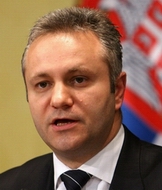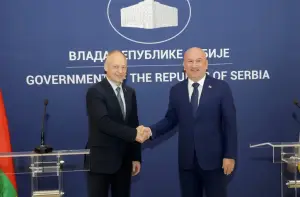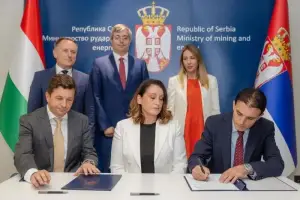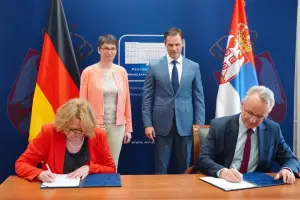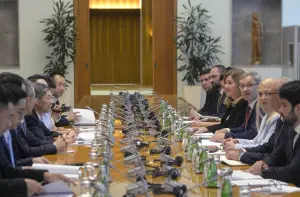Q:
A:
World Bank transfers $55 million to Serbian budget
Belgrade,
28 December 2005
Serbian Minister of Finance Mladjan Dinkic said that the World Bank transferred today to the Serbian budget an interest-free credit worth $55 million as support to structural reforms implemented by the Serbian government in 2005.
At a press conference, Dinkic said that this loan, with a 20-year repayment period, 10-year grace period and 0.75 percent annual expenses, represents just another international acclaim for successful economic policy of the Serbian government in 2005.
According to Dinkic, this loan represents one of the last loans to be granted to Serbia at such favourable conditions, because its GDP per capita has now exceeded €3,000.
Dinkic explained that the condition for granting this interest-free credit was the creation of a stable fiscal sector, restructuring of public enterprises, successful privatisation of state-owned companies and banks and general improvement of an investment climate in Serbia.
Dinkic said that by the end of the year all the preconditions necessary for calling a meeting of the Board of Directors of the International Monetary Fund (IMF) will be fulfilled, thus bringing about a successful conclusion to the sixth and last revision of the current three-year arrangement between Serbia-Montenegro and the IMF.
According to Dinkic, the session of the Board of Directors will probably be held on February 1, 2006. A successful completion of the three-year arrangement with the IMF will lead to a writing-off of an additional $700 million debt to the Paris Club of Creditors.
Speaking on the future cooperation with the IMF, Dinkic said that this institution has recommended a postponement of a new stand-by arrangement until the nature of relations between Serbia and Montenegro becomes clear. Until then, the IMF would monitor the implementation of the established economic policy in Serbia.
The minister said that all the objectives of the economic policy in 2005 have been realised, except inflation, and added that at the end of 2005, the country has seen a 16.5 percent increase in prices, which makes single-digit inflation the most important aim in the year to come.
Dinkic explained that the mechanisms for preventing further increase in prices have been created by limiting money supply for salaries of the employed in the public sectors, increasing budgetary surplus and controlling prices of services of public companies under the authority of local governments.
Dinkic pointed out that the greatest success in 2005 has been the introduction of the Value Added Tax (VAT), and added that GDP has grown by 6.5 percent, and currently stands at $3,200 per capita.
Participation of the public debt in GDP was reduced to 48.6 percent, and of the current payment deficit to 9-9.8 percent. Foreign direct investment this year came in at $1.5 billion, and privatisation revenues totalled 42 billion dinars.
Export was increased to $4.5 billion, while the total import was worth $11 billion. Therefore, the foreign trade deficit was reduced from $7.2 billion in 2004 to $6.5 billion this year.
Average salary in Serbia in 2005 rose by 5.8 percent against 2004 and now stands at €209. The unemployment rate was 0.9 percent, and 43,753 employees voluntarily left the public sector, said Dinkic.
He stressed that apart from reducing the inflation rate, one of the main goals of economic policy in 2006 will be to reduce the deficit in the current account of its balance of payment. "We are counting on a five percent economic growth, as well as on an increase in export and foreign direct investment", said the minister.
He voiced expectation that the privatisation of state-owned banks will be concluded in the course of 2006, as well as the sale of socially-owned companies, and that the privatisation of certain parts of public companies will also begin.
According to Dinkic, this loan represents one of the last loans to be granted to Serbia at such favourable conditions, because its GDP per capita has now exceeded €3,000.
Dinkic explained that the condition for granting this interest-free credit was the creation of a stable fiscal sector, restructuring of public enterprises, successful privatisation of state-owned companies and banks and general improvement of an investment climate in Serbia.
Dinkic said that by the end of the year all the preconditions necessary for calling a meeting of the Board of Directors of the International Monetary Fund (IMF) will be fulfilled, thus bringing about a successful conclusion to the sixth and last revision of the current three-year arrangement between Serbia-Montenegro and the IMF.
According to Dinkic, the session of the Board of Directors will probably be held on February 1, 2006. A successful completion of the three-year arrangement with the IMF will lead to a writing-off of an additional $700 million debt to the Paris Club of Creditors.
Speaking on the future cooperation with the IMF, Dinkic said that this institution has recommended a postponement of a new stand-by arrangement until the nature of relations between Serbia and Montenegro becomes clear. Until then, the IMF would monitor the implementation of the established economic policy in Serbia.
The minister said that all the objectives of the economic policy in 2005 have been realised, except inflation, and added that at the end of 2005, the country has seen a 16.5 percent increase in prices, which makes single-digit inflation the most important aim in the year to come.
Dinkic explained that the mechanisms for preventing further increase in prices have been created by limiting money supply for salaries of the employed in the public sectors, increasing budgetary surplus and controlling prices of services of public companies under the authority of local governments.
Dinkic pointed out that the greatest success in 2005 has been the introduction of the Value Added Tax (VAT), and added that GDP has grown by 6.5 percent, and currently stands at $3,200 per capita.
Participation of the public debt in GDP was reduced to 48.6 percent, and of the current payment deficit to 9-9.8 percent. Foreign direct investment this year came in at $1.5 billion, and privatisation revenues totalled 42 billion dinars.
Export was increased to $4.5 billion, while the total import was worth $11 billion. Therefore, the foreign trade deficit was reduced from $7.2 billion in 2004 to $6.5 billion this year.
Average salary in Serbia in 2005 rose by 5.8 percent against 2004 and now stands at €209. The unemployment rate was 0.9 percent, and 43,753 employees voluntarily left the public sector, said Dinkic.
He stressed that apart from reducing the inflation rate, one of the main goals of economic policy in 2006 will be to reduce the deficit in the current account of its balance of payment. "We are counting on a five percent economic growth, as well as on an increase in export and foreign direct investment", said the minister.
He voiced expectation that the privatisation of state-owned banks will be concluded in the course of 2006, as well as the sale of socially-owned companies, and that the privatisation of certain parts of public companies will also begin.

